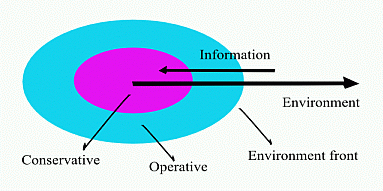|
The
Principle
of Asynchronous Evolution

All
biological theories especially classical genetics and
Darwinism silently assume the idea of synchronous
evolution. This approach is suitable for the description of
evolution of unitary systems. However, these theories
can not explain behavior of binary systems same as
you can not solve three-dimensional problem within a plane.
Binary systems
have two subsystems
(or forms) of relatively homogeneous elements. In the
case of population they are male and female sexes.
Evolution is a process of changing and involves time.
There are two distinct scales of time relative to species
development—Ontogeny (the development of an
individual from egg to adult) and Phylogeny (the
evolutionary history or genealogy of a species). During
Ontogeny egg, fetus, infant, child and adult male are
different phases of development of a male subsystem.
Most evolutionary changes occur during long periods of time
(Phylogeny time scale) and subsystems itself can
be viewed as phases rather then two different static forms.
[The similar situation was in astronomy until it was
discovered that white dwarfs and red giants are two phases
of star development]
Theory of Asynchronous Evolution introduces a principle of
Conjugated Subsystems:
any SYSTEM adaptiNG TO A variable environment dividES into
two conjugated SUBSYSTEMS, specialized according to
conservative and operative trends of evolution, WHICH
increases the SYSTEM stability as a whole.
When a system is
divided into subsystems, then a major question is about the
sequence of arrival of the controlling information from the
environment to these subsystems. Initially when the system
was uniform, the general stream of information was from the
Environment to the System: E → S. After the
appearance of the connected subsystems the information flow
becomes: Environment → Operative → Conservative Subsystem,
E → OS → CS. This means that the new
subsystem is always operative and arises between a
conservative subsystem and environment.
The subsystems change at a different speed. Operative
subsystem starts the change, verifies and selects the useful
traits and then passes them to conservative subsystem. This
delay creates a difference between the two subsystems both
in morphological (dimorphism)
and time (dichronism) aspects (Figure
1, 2.).

Figure 1.
On “system—environment” axis
system is divided onto “stable nucleus” and “labile shell”.

Figure 2.
On
time axis operative
subsystem can be considered
as “avant-garde” compare
to conservative one.
The
differentiation of a population into sexes, a bilateral
organism into the left and right halves, a forebrain into
hemispheres, a genome into autosomes and
sex chromosomes, a human
society into righthanded and lefthanded individuals can all
be considered as conservative and operative specializations
(Table).
They ensure an economic informational interaction of the
adaptive system with the environment and the efficient
evolution of this system.
All of these specializations resulted from asynchronous
evolution; i.e., the operative subsystems (the male sex, the
right half of the body, the left hemisphere, gonosomes, and
lefthanded individuals) change earlier than the respective
conservative subsystems. These dichronisms determine the
sexual (SD), lateral, chromosomal, and mental dimorphisms,
ensuring an evolutionary “distance” between the subsystems,
which is necessary for searching and testing innovations.
Based on this innovative approach V. Geodakyan created the
whole set of theories related to different levels of
organization from chromosomes to
populations.
New view on evolutionary role of sex leads to a proper
understanding of all sex-associated derivatives: sex ratio,
sex variation (SV), sexual dimorphism (SD),
sex chromosomes
(SC), sex hormones (SH), psychological differences
associated with sex, and all other sex-related phenomena.
Theory
can answer many questions which
Darwin's theory of sexual selection failed to explain.
Table.
Examples of conjugated subsystems.
|
System |
Subsystems |
|
Conservative |
Operative |
|
Nucleoprotein |
DNA (RNA) |
Protein |
|
Gene
(in the organism) |
Dominant
(A) |
Recessive (a) |
|
Gene (in
population) |
Heterozigote (Aa) |
Homozigotye (AA, aa) |
|
Genome |
Autosomes |
Sex chromosomes |
|
Cell |
Nucleus |
Cytoplasm |
|
Brain
(down—up) |
Subcore |
Core |
|
Brain
(back—front) |
Occipital lobe |
Frontal
lobe |
|
Brain (right—left) |
Right
hemisphere |
Left
hemisphere |
|
Organism (morphology) |
Left
side |
Right
side |
|
Organism
(genetics) |
Gametes |
Somatic
cells |
|
Organism
(physiology) |
Estrogens |
Androgenes |
|
Organism |
Genotype |
Phenotype |
|
Population |
Female
sex |
Male sex |
|
Society |
Righthanded individuals |
Lefthanded individuals |
Continue:
Sex Chromosomes: What Are They For?
The Evolutionary Theory of Sex
Evolutionary Theories of Asymmetrization of Organisms, Brain
and Body
|